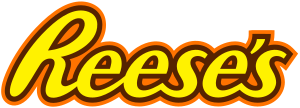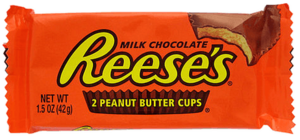Reese's Peanut Butter Cups facts for kids
 |
|

Reese's Peanut Butter Cup consists of smooth peanut butter filling inside of Hershey's chocolate.
|
|
| Type | Chocolate |
|---|---|
| Owner | The Hershey Company |
| Country | United States |
| Introduced | November 15, 1928 |
| Related brands | |
| Markets | Worldwide |
| Previous owners |
|
Reese's Peanut Butter Cups are a super popular American candy. They have a yummy peanut butter filling inside a chocolate cup. These treats were first made on November 15, 1928, by a man named H. B. Reese. He used to be a dairy farmer and even worked for Milton S. Hershey, who started the Hershey chocolate company.
Reese's Peanut Butter Cups are one of the best-selling candies around the world!
Contents
The Sweet Story of Reese's
How Reese's Began
The H.B. Reese Candy Company started in 1923 in Hershey, Pennsylvania. H. B. Reese first called his candies "Penny Cups" because they cost just one cent each. Mr. Reese had worked on a dairy farm for Hershey, and he always used Hershey chocolate in his sweets.
Reese's Peanut Butter Cups quickly became his most popular candy. Because they were so loved, Reese decided to stop making his other candies and focus only on the Peanut Butter Cups.
Growing Bigger and Better
H. B. Reese passed away in 1956, and his six sons took over the company. In 1963, the Reese brothers joined their company with the Hershey Chocolate Corporation. By 1969, Reese's Peanut Butter Cups became the top-selling candy for The Hershey Company!
The H.B. Reese Candy Company still operates as a special part of Hershey. In 2012, Reese's was the best-selling candy brand in the United States. It was also the fourth best-selling candy brand globally.
As of October 2017, Reese's was the biggest candy brand in U.S. convenience stores. More families bought Reese's products than any other candy brand. Reese's also sells the top-selling candy item, the Reese's Peanut Butter Cups King Size. Plus, Reese's makes up a huge part of holiday candy sales for Valentine's Day, Easter, Halloween, and Christmas.
Awesome Reese's Variations
Reese's makes many different kinds of Peanut Butter Cups and special limited editions.
Different Sizes of Cups
- Big Cup: This is a thicker version of the classic Reese's Peanut Butter Cup. It became a regular item in 2005. You can find it with different fillings like potato chips, pretzels, or even Reese's Pieces inside!
- King Size: This larger size was introduced in 1987.
- Miniatures: These are tiny, bite-sized versions that came out in 1978.
- Thins: These cups are 40% thinner than the original. They were introduced in 2018.
- Sugar Free: These are just like the original but without sugar. They first appeared in 2003.
- World's Largest: Each of these huge cups weighs about 8 ounces! They were introduced in 2011.
Fun Filling Changes
- Caramel: This cup has an extra layer of caramel. It was first available in 2006 and came back in 2023.
- Chocolate Lava: A big cup with a gooey chocolate lava layer. This was introduced in August 2024.
- Crunchy: This cup uses crunchy peanut butter instead of the smooth kind. It has been available on and off since the 1970s.
- Crunchy Cookie Cup: This cup has crushed chocolate cookies mixed with the peanut butter. It was first available in 1997 and returned in 2017.
- Double Chocolate: This limited edition had chocolate fudge filling instead of peanut butter. It was available in 2006.
- Double Crunch: A cup with a peanut filling, similar to a Snickers bar. This was released in late 2010.
- Hazelnut Cream: This version had hazelnut filling instead of peanut butter. It was only available in Canada.
- Honey Roasted: A cup with honey roasted peanut butter. It was brought back in 2017 for a limited time.
- Marshmallow: This cup had an added layer of marshmallow filling. It was available in 2007.
- Peanut Butter & Banana Creme: This cup had a banana crème layer and peanut butter filling. It was a tribute to Elvis Presley and was available in 2007.
Different Chocolate Coatings
- Chocolate Lovers: This cup has more chocolate and less peanut butter. It was available from 2003–2005 and returned in Summer 2019.
- Dark Chocolate: This version has peanut butter filling in a dark chocolate cup. It became a permanent item in 2009.
- Fudge: A thicker, darker chocolate cup with peanut butter filling. It was available in 2004.
- White Creme: This cup has peanut butter filling in a white chocolate coating. It became a permanent part of the Reese's line in December 2003.
Mix of Coating and Filling Changes
- Extra Smooth & Creamy: This version had smoother chocolate and peanut butter. It was available in the early 2000s.
- Inside Out: This was a fun twist with chocolate filling inside a peanut butter cup! It was available in 2005.
- Peanut Butter Lovers: This cup has an extra layer of peanut butter on top of the chocolate. It was available from 2003–2005 and returned in Summer 2019.
Holiday Editions
Reese's makes special shapes for different holidays! They are usually sold in packs of six.
- Reese's Peanut Butter Hearts: These heart-shaped candies are for Valentine's Day in January and February. They first launched in 1997.
- Reese's Peanut Butter Roses: Also for Valentine's Day.
- Reese's Peanut Butter Eggs: These egg-shaped candies are for Easter in March and April. They come in milk chocolate, white chocolate, or fudge flavors. They were first tested in 1966 and launched nationally in 1967.
- Reese's Peanut Butter Pumpkins: These pumpkin-shaped candies are for Halloween in September and October. They launched in 1993. White Creme pumpkins were added in 2017.
- Reese's Peanut Butter Ghosts: Ghost-shaped candies for Halloween, first released in 2016.
- Reese's Peanut Butter Franken-Cup: This candy had green white crème and milk chocolate. It was sold from 2020 to 2023.
- Reese's Werewolf Tracks: These werewolf-shaped candies were released in 2024, replacing the Franken-Cup.
- Reese's Peanut Butter Bats: Bat-shaped chocolate candies for Halloween.
- Reese's Peanut Butter Christmas Trees: These evergreen tree-shaped candies are for Christmas in November and December. They come in milk chocolate or white chocolate.
- Reese's Peanut Butter Bells: These bell-shaped candies are smaller than a regular cup.
- Reese's Peanut Butter Bunny: A larger, individually wrapped Easter Bunny.
- Reese's Snowman: This peanut butter snowman is three times bigger than the tree, egg, or pumpkin shapes.
- Reese's Peanut Butter Ugly Sweater: Candy shaped like an ugly sweater, a fun Christmas gift.
- Reese's Peanut Butter Footballs: Candy shaped like a football, available during football season.
- Reese's Milk Chocolate Peanut Butter Nutcrackers: Candy shaped like a nutcracker doll for Christmas.
- Reese's Peanut Butter Santas: These are shaped like Santa Claus.
Other Delicious Reese's Products
- Reese's Crispy Crunchy is a candy bar with flaky peanut butter and chopped peanuts covered in milk chocolate. It came out in 2006.
- Reese's Cluster Bites are small candy clusters with peanut butter, caramel, and peanuts, all covered in milk chocolate.
- Reese's Fast Break has peanut butter over a soft nougat layer, covered in chocolate. It was introduced in 2001.
- Reese’s Plant Based Peanut Butter Cups are made with oat milk instead of cow's milk. They were introduced in the U.S. in 2023.
- Reese's Snack Bar has peanut butter creme, crispy brown rice, roasted peanuts, and milk chocolate.
- Reese's Sticks are wafers filled with peanut butter and covered in chocolate. They were introduced in 1998.
- Reese's Whipps is a candy bar with peanut butter nougat and a layer of peanut butter and chocolate. It came out in 2007.
- Reese's Peanut Butter Ice Cream is chocolate and peanut butter flavored ice cream with mini Reese's Peanut Butter Cups.
- Reese’s Puffs is a breakfast cereal inspired by Reese’s Peanut Butter Cups.
Marketing and Fun Facts
In the United States, Reese's Peanut Butter Cups usually come in packs of 2, 4, 5, 10, or 20. They are known for their bright orange packaging. In Canada, they were once called "Reese Peanut Butter Cups" to be more bilingual. In the United Kingdom and Ireland, they are now available in packs of three or five, and as miniatures.
In the 1970s and 1980s, Reese's had famous commercials. They showed two people, one eating peanut butter and one eating chocolate, bumping into each other. They would say, "You got your peanut butter on my chocolate!" and "You got your chocolate in my peanut butter!" Then they would try the mix and love it, leading to the slogan: "Two great tastes that taste great together."
In the 1990s, the slogan changed to: "There's no wrong way to eat a Reese's."
Reese's has also sponsored NASCAR Cup Series drivers like Mark Martin and Kevin Harvick. Recently, Chicago Sky basketball player Angel Reese became a brand ambassador for Reese's. They even designed a special basketball jersey for her in Reese's colors!
See also



